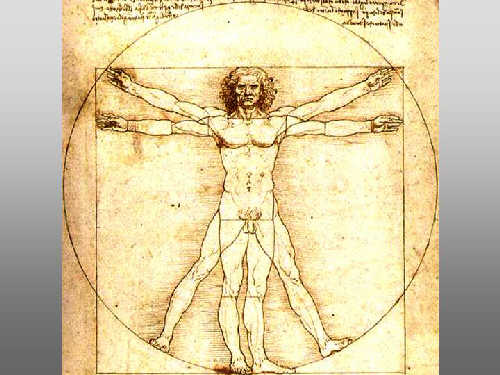
Vitruvian Man
|
A famed drawing by Leonardo of a man, front view and side, standing in a square within a circle. The first clue to the mysteries in The Da Vinci Code is Saunière having sprawled out his dying, naked body in emulation of this famous iconic Leonardo image. Vitruvian Man is named after Marcus Vitruvius Pollio, the Roman writer, architect, and engineer active in the first century BC. He was in charge of the aqueducts of Rome and wrote The Ten Books of Architecture, perhaps the first work on architecture ever written. Vitruvius's study of human proportions was in his third book, and he left this guide for artists and architects to follow:
The measurements of the human body are as follows that is that 4 fingers make 1 palm, and 4 palms make 1 foot, 6 palms make 1 cubit; 4 cubits make a man's height. And 4 cubits make one pace and 24 palms make a man. The length of a man's outspread arms is equal to his height. From the roots of his hair to the bottom of his chin is the tenth of a man's height; from the bottom of the chin to the top of the head is one eighth of his height; from the top of the breast to the roots of the hair will be the seventh part of the whole man. From the nipples to the top of the head will be the fourth part of man. The greatest width of the shoulders contains in itself the fourth part of man. From the elbow to the tip of the hand will be the fifth part of a man; and from the elbow to the angle of the armpit will be the eighth part of man. The whole hand will be the tenth part of the man. The distance from the bottom of the chin to the nose and from the roots of the hair to the eyebrows is, in each case the same, and like the ear, a third of the face.
Leonardo's contribution was to solve this ancient algorithm known as "squaring the circle," a geometric problem whereby a pair of compasses and a ruler are used in an attempt to construct a circle and square of equal area. Theoretically, a perfectly proportioned human would fit within the figure and while Vitruvius's efforts apparently remained crude, Leonardo's rendering is perfect and a work of mathematical as well as artistic genius.
